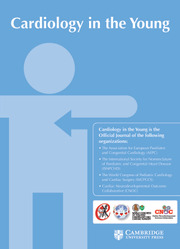No CrossRef data available.
Article contents
Accessory-pathway-mediated dilated cardiomyopathy in an infant
Published online by Cambridge University Press: 26 August 2025
Abstract
We report the case of a 10-month-old infant presenting with dilated cardiomyopathy caused by septal dyssynchrony linked to a right septal accessory pathway-mediated pre-excitation. No atrioventricular reciprocating tachycardia was reported, but this pre-excitation resulted in left septal dyssynchrony. After the introduction of flecainide therapy, the antegrade pre-excitation disappeared on ECG, leading to normalisation of left ventricular function.
Information
- Type
- Case Report
- Information
- Copyright
- © The Author(s), 2025. Published by Cambridge University Press
References
Udink, ten Cate FEA, Kruessell, MA, Wagner, K, et al. Dilated cardiomyopathy in children with ventricular preexcitation: the location of the accessory pathway is predictive of this association. J Electrocardiol 2010; 43: 146–154.CrossRefGoogle Scholar
Miyazaki, A, Uemura, H. Perspective of preexcitation induced cardiomyopathy; early septal contraction, and subsequent rebound stretch. J Cardiol 2022; 79: 30–35.CrossRefGoogle ScholarPubMed
Emmel, M, Balaji, S, Sreeram, N. Ventricular preexcitation associated with dilated cardiomyopathy: a causal relationship? Cardiol Young 2004; 14: 594–599.CrossRefGoogle ScholarPubMed
Couchonnal, LF, Chicos, AB, Knight, BP. An unusual level of block in a patient with an unusual accessory pathway. Cardiovasc Electrophysiol 2012; 23: 334–335.CrossRefGoogle Scholar
Zhang, Y, Jiang, H, Cui, J, Li, MT, Zhou, HM, Li, XM. Ablation of ventricular preexcitation to cure preexcitation-induced dilated cardiomyopathy in infants: diagnosis and outcome. Circ Arrhythm Electrophysiol 2023; 16: e011569.CrossRefGoogle ScholarPubMed
Sekine, M, Masutani, S, Imamura, T, et al. Improvement in dyssynchrony with pharmacological ablation of right-sided accessory pathway-induced cardiomyopathy in infants. Int Heart J 2019; 60: 1201–1205.CrossRefGoogle ScholarPubMed
Uthayakumaran, G, Asakai, H, Gnanappa, G. Pharmacological resynchronisation with flecainide in an infant with Ebstein anomaly and Wolff-Parkinson-White pattern: a case report. Eur Heart J Case Rep 2024; 8: ytae442.CrossRefGoogle Scholar
Cardiac Arrhythmia Suppression Trial (CAST) Investigators. Preliminary report: effect of encainide and flecainide on mortality in a randomized trial of arrhythmia suppression after myocardial infarction. N Engl J Med 1989; 321: 406–412.CrossRefGoogle Scholar
Cunningham, T, Uzun, O, Morris, R, et al. The safety and effectiveness of flecainide in children in the current era. Pediatr Cardiol 2017; 38: 1633–1638.CrossRefGoogle ScholarPubMed
Kohli, V. Oral flecainide is effective in management of refractory tachycardia in infants. Indian Heart J 2013; 65: 168–171.CrossRefGoogle ScholarPubMed

